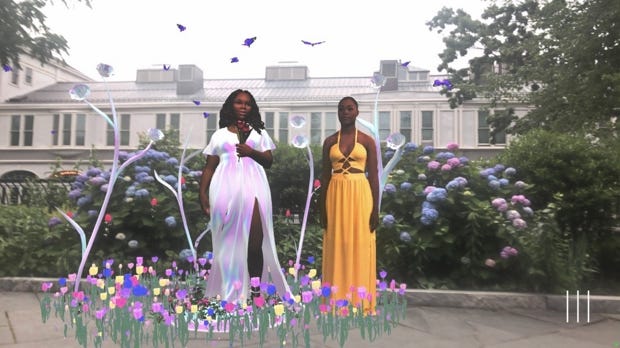Welcome to our newsletter now on Substack. We’re glad to see you here. We’re hoping this will give us more opportunities to grow the newsletter and the Immerse community. This is a work in progress and we welcome feedback!
Here’s an introduction to our latest issue from Immerse Editor, Abby Sun:
For the “Playing with Reality” issue of Immerse, we started by thinking about games as a vehicle for nonfiction methods of recording, mediating, and conveying reality. Many immersive nonfiction projects are built with game engines and experienced with the same gear or through the same platforms. The direct crossovers in software and hardware, however, are but one way of considering the importance of considering games in our field.
In covering developments of a broad range of games, from the self-aware hijinks of lyric games to the utility of business-oriented strategy card decks (the latter from Immerse publisher Jessica Clark), we are thinking of gaming not only as a wrapper for nonfiction content. Instead, we turn the focus onto an industry with its own infrastructures of production and distribution, a broad set of tools which can be further developed for nonfiction immersive storytellers, and a unique disposition.
The longest piece in this issue is a wide-ranging conversation between desktop documentary pioneer Kevin B. Lee and new media artist Grayson Earle. Like the other pieces in this issue, their provocations render clear the different interventions that users can exert on larger systems, starting with the act of modifying games. The writing in this issue also takes a granular approach in investigating narrative, spatial, and interactive design elements such as dialogue and decision trees, rendering limitations, and other gameplay mechanics through the online data dungeon performance “Play4UsNow,” DREAMFEEL’s Curtain, “essay games” 1979 Revolution: Black Friday and Attentat 1942, and Bryan LeBeuf’s interactive documentary Home Movie.
During our publishing period, we also launched a new section of Immerse called ICYMI: In Case You Missed It. Curated by Engagement Editor Ngozi Nwadiogbu with great insight and humor, each weekly ICYMI round-up spotlights significant events and thoughtful conversations around immersive nonfiction on social media platforms. Meanwhile, we also playfully covered, in interview format, two projects that showed up at the perennial showcases of Sundance New Frontier and Tribeca Immersive, as well as a dispatch from Black Public Media’s new pitch forum for Black AR/VR/XR nonfiction projects.
Our interest in and coverage of more game-related immersive projects only starts here, and we look forward to publishing more pieces to come.
What we’re reading and watching
Randy Astle covers the immersive and interactive work at Tribeca last month.
Deepfakes and documentary: Morgan Neville used AI technology to digitally re-create Anthony Bourdain’s voice. “We can have a documentary-ethics panel about it later,” he said to the New Yorker but Twitter is having this debate now. Sam Gregory is always perceptive on these issues.
NEA have published Tech as Art: Supporting Artists Who Use Technology as a Creative Medium with much of the research conducted by Immerse publisher Jessica Clark. Take a look also at the commissioned essays from arts practitioners.
Peabody Awards will recognize achievements in interactive and immersive storytelling and Immerse editorial collective member Kat Cizek is on the board. The board is also chaired by Diana Williams. This is great news all round.
We need to kick big tech out of the metaverse. WIRED on the need for opennness.
Artists Es Devlin, James Turrell, teamLab and DRIFT kick off the inaugural program at experimental art company Superblue in Miami.
Zhengzhou, the capital of China’s Henan province, has opened the largest immersive theatre complex in the world, known as Unique Henan – Land of Drama.
Projects we’re eyeballing
We Dwell in Possibility is a queer gardening simulation designed by Robert Yang, a videogame developer whose work explores gay subcultures and intimacy, with visuals by cartoonist and illustrator Eleanor Davis.
Darkfield Radio season 2 is currently transmitting. All you will need to access the experience is your phone, the Darkfield Radio app, your tickets and headphones.
Take a look at this collection of 360 VR projects on MIT Open DocLab’s VR For All playlist: projects include Collisions, Notes on Blindness, The Other Dakar (exec produced by me so I’m a tad biased but it’s wonderful), and more gems.
Coming up
Festivals and events
Gray Area Festival is September 23-26 and they have introduced membership-based ticketing which is really smart. Speakers include Stephanie Dinkins and new Immerse editorial board member Amelia Winger-Bearskin.
Submission deadlines
Oculus Launch Pad is open for applications. Deadline July 30.
FLAT journal has a call for papers on the subject of “touch”. Deadline August 1.
Geneva International Film Festival submissions deadline for immersive work is August 17.
Immerse is an initiative of MIT Open DocLab and Dot Connector Studio, and receives funding from Just Films | Ford Foundation and the MacArthur Foundation. The Gotham Film & Media Institute is our fiscal sponsor. Learn more here. We are committed to exploring and showcasing emerging nonfiction projects that push the boundaries of media and tackle issues of social justice — and rely on friends like you to sustain ourselves and grow. Join us by making a gift today.
Publisher: Jessica Clark (Dot Connector Studio)
Editor: Abby Sun (MIT Open Doc Lab)
Associate Editor: Carrie McLaren (Dot Connector Studio)
Engagement Editor: Ngozi Nwadiogbu
Editorial Collective: Sarah Wolozin (MIT Open DocLab), Ingrid Kopp (Electric South), Kat Cizek (MIT Open DocLab)
Producer: Claudia Romano (MIT Open DocLab)
Editorial Board:
Zeina Abi Assy, Mark Atkin (Crossover Labs) , Ruthie Doyle (Sundance Film Institute), Caspar Sonnen (IDFA DocLab), Julia Scott-Stevenson, Amelia Winger-Bearskin
Design: Hayrettin Gunc





Go Ingrid!